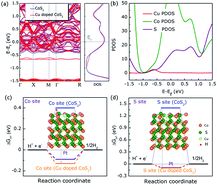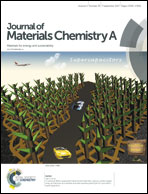Copper dopants improved the hydrogen evolution activity of earth-abundant cobalt pyrite catalysts by activating the electrocatalytically inert sulfur sites†
Abstract
Cobalt pyrite (CoS2) is considered to be a promising catalyst for the hydrogen evolution reaction (HER) due to its intrinsic metallicity and high catalytic activity. However, the catalytically inert S-sites and sluggish reaction kinetics severely impede its commercial application. Herein, combining systematic theoretical and experimental approaches, a highly active and stable Cu doped CoS2 catalyst for the HER is demonstrated. Cu dopants are proven to not only reduce the hydrogen adsorption free energy (ΔGH*) of the Co sites from 0.41 eV to −0.13 eV, but also arouse the inert S sites with the low ΔGH* of −0.11 eV. A large cathode current density (10 mA cm−2 at 52 mV), low Tafel slope (42 mV dec−1), large exchange current density (0.68 mA cm−2), and good stability were observed in the Co0.93Cu0.07S2 catalyst, which are better than those found for the previously reported CoS2-based catalysts. The success of improving the electrochemical performance via the introduction of Cu dopants offers new opportunities in the development of high performance CoS2-based electrodes for other energy-related applications.



 Please wait while we load your content...
Please wait while we load your content...